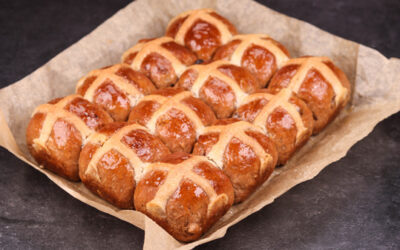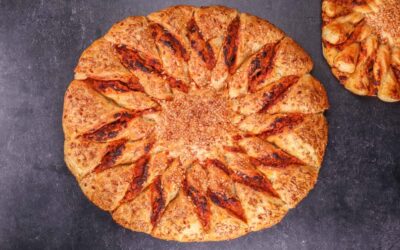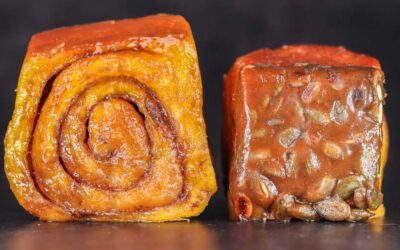Poppy seed rolls are a delicious Christmas classic in many European countries. And the Europeans do not skimp on the poppy seeds either. The rolls must be loaded as historically it was a way to show how wealthy one’s family was.
Nowadays poppy seeds are cheap as chips so there is no reason not to load up your rolls with this tasty filling.
A bit of lemon zest in the filling and in the dough elevates the flavour of this soft and fluffy Christmas bread.
If you have made cinnamon rolls, then the process will be quite familiar to you. The only thing unique is the filling which must be cooked and cooled before use. I decided to make this recipe with a quick preferment (sponge) to give in an extra airy texture. You could skip this step by simply mixing all the ingredients together from the get-go.
The rolls are perfectly fine, delicious, and beautiful as they come out of the oven, but you can do what I did and decorate them with icing and various toppings.
And if you are not into poppy seed rolls, then check out the Breads of Christmas playlist on my channel for many more awesome Christmas bread recipes from all over the world.
Watch the video down below for detailed instructions.
Ingredients
For the sponge (preferment) –
50g (1.75oz) strong white bread flour
50g (1.75oz) milk, at room temperature
3g (0.1oz) instant dry yeast or 3.6g (0.12oz) active dry yeast or 9g (0.3oz) fresh yeast
For the main dough –
210g (7.4oz) strong white bread flour
5g (0.17oz) salt
25g (0.9oz) sugar
Zest of 1 lemon
1 egg, around 50g (1.75oz)
50g (1.75oz) milk
5g (0.17oz) vanilla paste/syrup/essence or 1/3 of a vanilla bean
40g (1.4oz) soft butter
*I am using cold egg and cold milk from the fridge to not warm up the dough too much when kneading.
To learn more about dough temperature when using a preferment click here.
For the filling –
150g (5.3oz) poppy seeds, ground
70g (2.5oz) sugar
70g (2.5oz) butter
70g (2.5oz) milk
Zest of 1 lemon
Egg to brush before baking
To decorate –
160g (5.7oz) icing sugar mixed with 28g (1oz) lemon juice until smooth.
Sliced almonds
Candied peel
Poppy seeds
Freeze dried raspberries
Of course, you can decorate your buns with whatever you fancy!
Method
- Make the filling. Bring the milk, sugar, butter, and lemon zest to a boil. Add the poppy seeds and mix well. Turn the heat down to low and cook the filling for 10 minutes stirring occasionally. Place in a bowl and leave to cool down completely.
- Make the sponge. In a large bowl combine the milk, yeast, and flour. Mix until there is no dry flour left. Cover and ferment for 1 hour or until well puffed up and bubbly.
- Make the main dough. Add the egg, milk, salt, lemon zest, sugar, and vanilla to the sponge. Mix well to dissolve the salt and sugar. Add the flour and mix to a dough.
- Tip the dough out on the table and knead it for 3 minutes. Tear in the butter and continue kneading for 4 more minutes. *Desired dough temperature 26C (79F). If your dough is warmer, then it will ferment more rapidly. If it is cooler, then it will take longer. Adjust proofing time accordingly.
- Cover and ferment for 1.5 hours.
- Fold.
- Ferment for 1.5 hours. *If your dough is rising rapidly, then ferment if for 1 hour.
- Roll the dough out to a long rectangle. Make sure it is as straight as possible. Take your time.
- Spread the filling on evenly leaving and edge at the top. Roll up the dough. Pull it back as you roll it to make the loaf tight. Seal it up with water.
- Dust a chopping board with flour and dust the loaf as well to prevent it from sticking. Using a serrated knife cut off the ends and divide the loaf into 6 equal pieces.
- Place the rolls on a non-stick paper lined tray with plenty of space between them. Flatten slightly.
- Final proof should take between 1.5 – 2 hours depending on the temperature of your kitchen. *During the final hour of fermentation preheat your oven to 160C (320F) fan on.
- Brush the rolls with egg and bake them for 20 minutes or until golden brown all over.
- Leave to cool down and enjoy with decorations or without.
You could bake this as a whole loaf too. After rolling it up leave it uncut and place it in a cake tin lined with non-stick paper. Baking time will have to double though.
Keep in mind that the conditions in each kitchen are different, so fermentation times may vary for you. It is up to the baker to control the bread and react accordingly.
Your oven may be different too, so your baking time may vary.
Watch the video here



